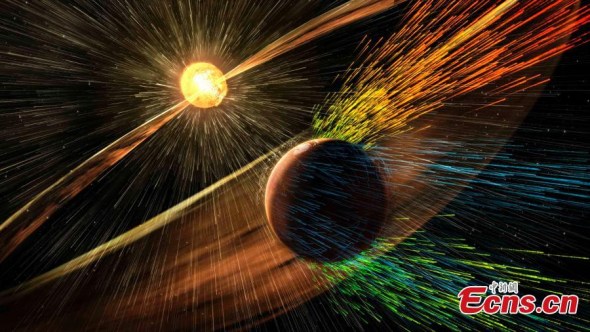
An undated artist's rendering depicts a solar storm hitting Mars and stripping ions from the planet's upper atmosphere in this NASA handout released Thursday. Scientists have documented a solar storm blasting away Mars' atmosphere, an important clue in a long-standing mystery of how a planet that was once like Earth turned into a cold, dry desert. (Photo/Agencies)
Solar wind may have played a key role in stripping away Mars' atmosphere, causing the once warm, wet planet that might have supported surface life to turn into a cold, arid world today, U.S. space agency NASA said Thursday.
New results from NASA's Mars Atmosphere and Volatile Evolution (MAVEN) mission, published in the journals Science and Geophysical Research Letters, revealed that the erosion of Mars' atmosphere increases significantly during solar storms in the past 4 billion years.
Today, the solar wind strips away gas at a rate of about 100 grams every second, it said.
"Like the theft of a few coins from a cash register every day, the loss becomes significant over time," said Bruce Jakosky, MAVEN principal investigator at the University of Colorado, Boulder.
Jakosky believed that the loss rate was "much higher" billions of years ago when the sun was young and more active.
"The combination of greater loss rates and increased solar storms in the past suggests that loss of atmosphere to space was likely a major process in changing the Martian climate," NASA said in a statement.
The findings were based on the study of a series of dramatic solar storms that hit Mars' atmosphere in March 2015.
The solar wind is a stream of particles, mainly protons and electrons, flowing from the sun's atmosphere at a speed of about 1 million miles per hour.
NASA explained that the solar wind can generate an electric field as it flows past Mars to accelerate electrically charged gas atoms, called ions, in the planet' upper atmosphere and shoot them into space.
New data indicated the loss comes from three different regions around the planet: down the "tail," where the solar wind flows behind Mars, above the Martian poles in a "polar plume," and from an extended cloud of gas surrounding Mars.
The science team determined that almost 75 percent of the escaping ions come from the tail region, and nearly 25 percent are from the plume region, with just a minor contribution from the extended cloud.
"Understanding what happened to the Mars atmosphere will inform our knowledge of the dynamics and evolution of any planetary atmosphere," John Grunsfeld, associate administrator for the NASA Science Mission Directorate, said.
"Learning what can cause changes to a planet's environment from one that could host microbes at the surface to one that doesn't is important to know, and is a key question that is being addressed in NASA's journey to Mars."
Launched in 2013, the MAVEN spacecraft is to determine how much of Mars' atmosphere and water have been lost to space. It has been operating at Mars for just over a year and will complete its primary science mission on Nov. 16.


















































